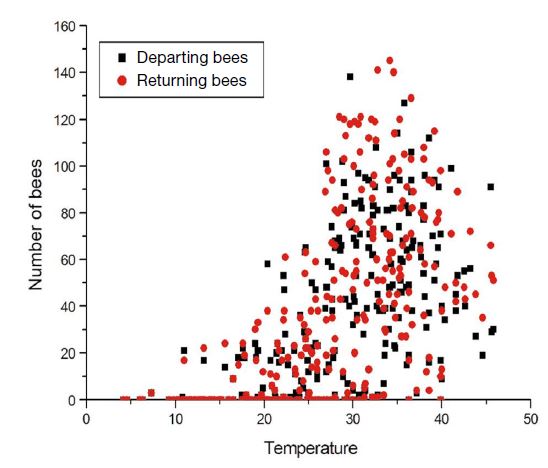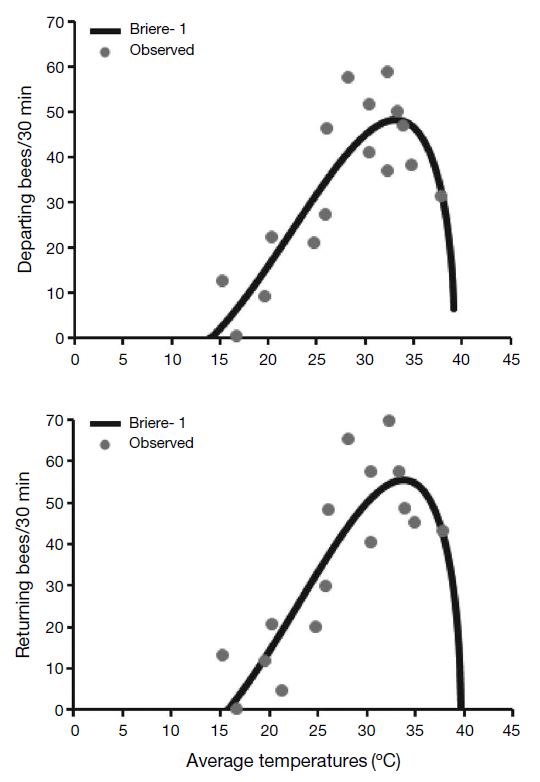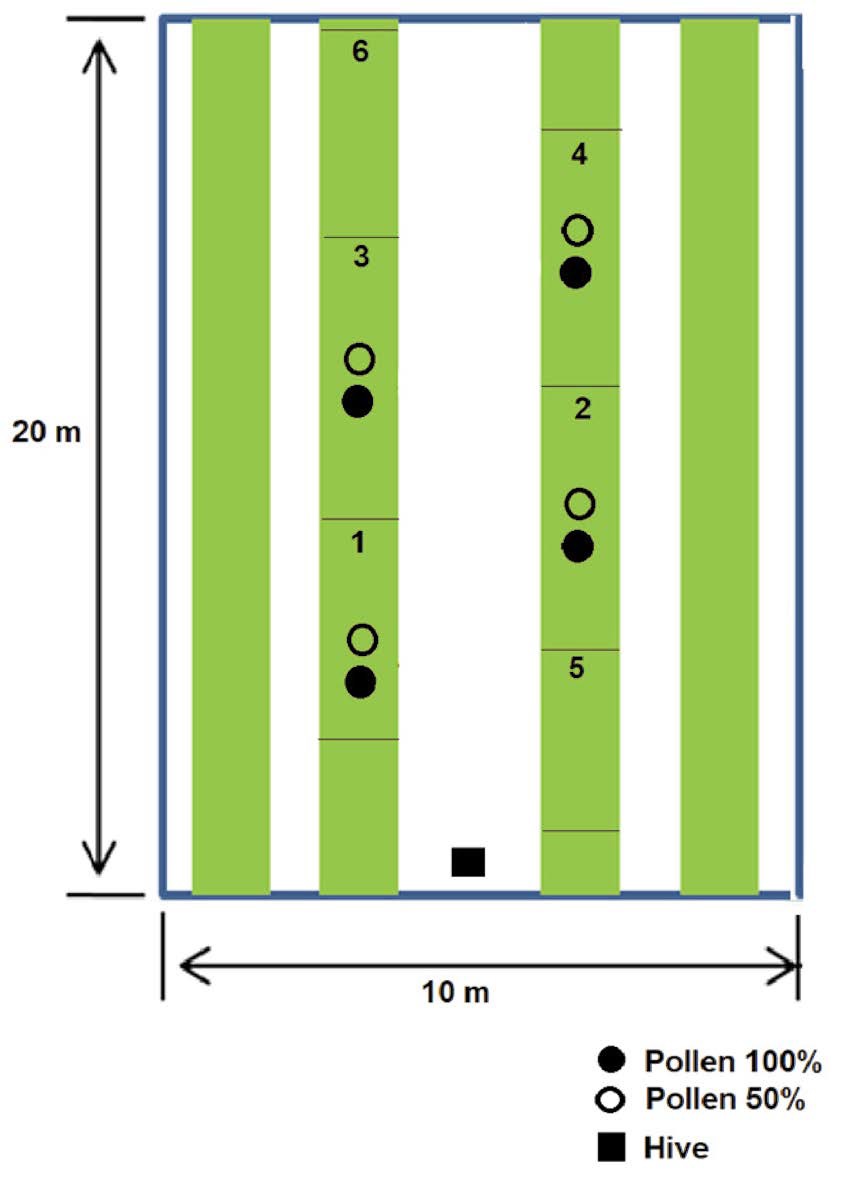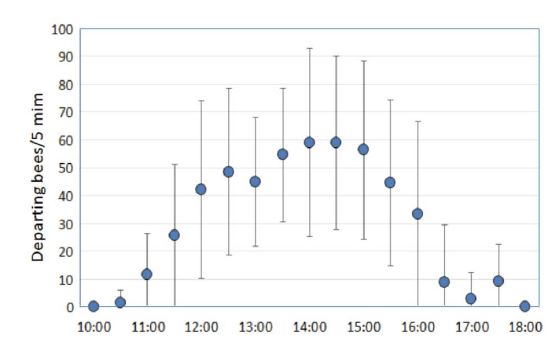
Offering Pollen as Reward Enhances Foraging Activity of Honey Bee, Apis mellifera on Strawberry Greenhouse during Winter Season
Abstract
Production of many crops benefits from elevated pollinator diversity and abundance. We assessed the effect of pollen supplement on the foraging activities of Apis mellifera in strawberry greenhouse. Since bees can learn floral resources in association with pollen rewards, we tested whether offering pollen supplement food enhances foraging activity and consequently increases pollination by honey bees in greenhouse. We observed number of departing and returning bees from the hive entrances with fixed interval from 10 am to 6 pm with temperature and humidity recording. And we checked number of foragers that visit artificial food (pollen: rice powder; 1 : 0, 1 : 1) and flowers. Honey bee foraging was highly dependent on the temperature inside the greenhouse. Minimum temperature for honey bee activity was observed from 14℃ with maximum activities at 33.1~33.3°C. Above 39°C, no foraging was observed. Foraging activity of bees significantly increased after offering pollen supplement food; average number of bees departing 23.3±3.06 and returning 24.8±3.51 were increased to 39.3±2.53, 44.9±2.91 respectively after offering pollen supplements. Frequencies of foraging on two different pollen supplements (high vs low protein) were not significant. Visiting duration of strawberry flowers in plots with and without pollen supplements were not different. Increased foraging activity by increasing the number of foragers that enhances high bee visitation rates by offering pollen supplement foods can be the indication of pollination efficiency.
Keywords:
Foraging activity, Apis mellifera, Pollen supplement food, Flower visiting duration, Visitation intervalINTRODUCTION
Pollinators plays a crucial role in most terrestrial ecosystems by providing a key ecosystem service in maintenance of both wild and agricultural plant communities (Choi and Jung, 2015; Gill et al., 2016). Insect pollination for fruit set and seed development accounts 75% of agricultural crops of the world (Klein et al., 2007). Pollinators do not only help increasing the production, but also affect the nutritional quality of the crops (Ghosha and Jung, 2018). A number of insect species pollinate a wide variety of plants grown in greenhouse (Choi and Jung, 2015). Honey bees are the main horsepower of insect pollinators followed by bumblebees (Choi and Jung, 2015). Alternative use of honey bees for pollinating vegetable crops in greenhouse increased due to their greater availability and low cost (Kalev et al., 2002). Economic benefits of pollination by honey bees (Apis mellifera L.) was estimated to be 4.25 billion Euros in Europe and 0.75 billion Euros by other taxon (Albano et al., 2009).
Managed species of honey bees like Apis mellifera and Apis cerena were recognized as essential pollinators for strawberry flower (Nye and Anderson, 1974). Pollination by those bee species enhances the quality and quantity of strawberry fruit in Europe and Southern Asia (Free, 1993; Sommeijer and Ruijter, 2000). Through the European honey bee, A. mellifera, has been practically used as pollinators (Free, 1968); some problems have been facing in use of the A. mellifera for pollination of strawberry. Honey bee colony can suffer from the death of workers, low foraging efficiency in greenhouses (Katayama, 1987), limited foraging range that resulted in bees fly upward to the greenhouse ceiling and dying (Visscher and Seeley, 1982; Seeley, 1985), parasites, africanisation phenomenon in USA and the rise of rental prices (Delaplane et al., 2000).
Difference in floral character between plant species influence pollinator’s foraging behavior and pollinating success. These characters are visual cues (flower shape and color), olfactory cues like floral volatiles, and the quantity and chemical composition of nectar and pollen rewards (Mallinger and Prasifka, 2017). For several crops grown globally, floral character that enhances pollinator attraction could result in greater crop yields. For instance, higher nectar volume increased honey and bumble bee visits to certain onion and zucchini cultivars, while higher quantities of floral volatiles increased wild solitary bee visits to certain strawberry cultivars (Mallinger and Prasifka, 2017).
Pollen, the male gamete in sexual reproduction is produced by all angiosperm species. Foraging bees collect pollen as primary source of protein, lipid and micronutrients like minerals necessary for bee’s health (Ghosh et al., 2020) in addition to nectar which is primary source of carbohydrates. At least 6% of angiosperms (around 22,000 species) offer only pollen rewards in exchange for the service of pollination (Vogel, 1978). Pollen foraging bumble bees displayed modest innate preferences for certain pollen-only plant species, but formed strong, lasting preferences for even initially less-preferred species after experiencing collecting pollen from plants (Russell et al., 2016).
The pollination efficiency of a strawberry floral visitor was measured through the determination of pollination rates resulting from a single visit, fertilization efficiency per visit and flower visiting frequency. Pollen based supplemented foods may result in increasing pollination by honey bee foragers. This particular study aims to assess offering pollen supplemented food to foragers increase foraging activity of honey bees that enhance pollination of strawberry in greenhouse.
MATERIALS AND METHODS
1. Honey bees and greenhouse
The experiment was conducted in a strawberry plantation during blooming period from early February to late March of 2020 planted in auto cleaved greenhouse (36°5ʹN, 128°8ʹE; 4 multi-span, PO film; width, 25 m; length, 24 m; height, 9.6 m) at Andong National University. The strawberry cultivar of ‘Sulhyang’ seedling was used at the experiment. ‘Yamazaki’ nutrient solution (Ca2+ 11.4 meq·L-1, Mg2+ 3.8 meq·L-1, K+ 1.4 meq·L-1, NH4+ 0.82 meq·L-1, NO3- 4.8 meq·L-1, SO4- 0.4 meq·L-1, and PO4- 0 meq·L-1) was used for automatic irrigation based on accumulated radiation. One health honey bee, Apis mellifera colony that contains 5 frames was taken from the experimental apiary of Andong National University and installed in the greenhouse. The colony was queen-right and balanced frame composition with 2 brood frames and 3 food frames. The queen was requeened in spring season. Inside temperature and relative humidity (RH) of the greenhouse for strawberry cultivation were maintained at 5~30℃ and 60~95%, respectively. Shade screen was automatically operated based on light intensity (700 W m-2) for greenhouse inside temperature control. Inside and outside environmental data were collected and stored in the data logger (CR1000, Campbell scientific, USA) every second.
2. Monitoring foraging activity
From January to March 2020, we recorded the temperature and humidity of greenhouse in which strawberry grew in for 30 min time intervals from 10:00 am to 6 pm using a hand-held LCD temperature humidity meter thermometer (HTC-1). In the beginning, we made preliminary observation and found honey bee activities only on those time frame. We made observation on the number of foragers departing and returning to our experimental colony. Visual inspections from the entrance of the honey bee hive was conducted for 5 minutes each for every 30 minutes from 10 am to 6 pm. Two persons are involved in visual inspection. Monitoring was conducted at least 2 times per week for seven days before and twelve days after offering pollen supplemen. Also, we measured flower visitation frequency per min (which refers to the number of flowers that each honey bee visits per min) were observed using the stopwatch matching method (He et al., 2019).
3. Effect of reward offering treatment
To evaluate if the protein reward offering could enhance honey bee foraging activities, powdered protein sources were prepared. The high protein reward was 10g rape seed pollen powder and the low protein reward was the mix of 5 g rape seed pollen powder and 5 g rice powder (Ghosh et al., 2020). We presented a pair of two rewards at 4 sites and the other two sites were remained as negative control inside the greenhouse (Fig. 1). We kept providing new reward 10 am every day, and withdraw at 6 pm. Then we compared the foraging activities of departing and returning foragers, and flower visit frequencies before and after offering rewards. Also, we compared the reward uptake by foragers by measuring weight at 10 am and 6 pm.
4. Data analysis
Data are presented as the mean±standard error (mean±SE) and were analyzed with SPSS 16.0. Independent t-tests were carried out to compare foraging activity of A. mellifera before and after offering pollen supplemented foods, honey bee visitation of flowers in sites, honey bees visitation to pollen supplement food (high vs low protein), mass of pollen supplement foraged by bees, visitation frequency per minute.
Additionally, we constructed model to explain the temperature dependent honeybee foraging pattern. Data for this model construction were selected from the observed data on strawberry greenhouse during January to March 2020. We tested most widely used models i.e. Logan-6/Lactin-1, Logan-6/Lactin-2, Analytis-3/Briere-1 and Analytis-3/Briere-2 (Noor and Jung, 2020) to evaluate the temperature and foraging activity. We selected same approach to select best model as described by Noor-ul-Ane et al. 2019 which is short listing of models based on Akaike information criterion (AIC) and then finally selected best model based on its biological significance (temperature thresholds). The parameters were calculated using TableCurve 2D software (Jandel Scientific, 1996).
Where, p is the number of estimated parameters for the model, ln is the natural log, n is number of observations. SSE is the sum of squares for the model error term.
RESULTS
1. Foraging activity
According to our observation, in rainy and windy day, A. mellifera foragers were not gone out to collect pollen and nectar where as in sunny and good weather day, A. mellifera begun flying out after 10:30 am. In most cases, before 10:00 am; auto cleaved greenhouse was not opened and the temperature remained less than 10°C. When the temperature was between 12~16°C, a small number of A. mellifera began to fly out of the nest, while most of the bee visitation occurred after 11:00 am, when the temperature rose to 20~25°C. As the temperature increases, departing bees increases and reached its climax from 12:00~1:00 pm and 14:00~15:30 pm when the temperature is 29~33°C (Fig. 2). Almost all bees stopped their visitation around 17:30 pm (Fig. 3).

Temperature-foraging activity of Aphis mellifera on the on strawberry greenhouse during January to March, 2020.
2. Effect of reward provision
Offering pollen supplement foods increases the foraging activity of honey bees that intern increases bees pollination of strawberry in greenhouse. In the present study, there were significantly difference in foraging activity of honey bees before (checked for 7 days and 105 times) and after offering pollen supplement foods (checked for twelve days and 181 times), (departing bees: t-test, df=232.3, 286, t= -4.042, P<0.001; returning bees: t-test, df=231.8, 286, t= -4.404, P<0.001) (Fig. 2), (flowers visitation: t-test df=469.8, 607, t=2.946, P=0.003). But there was no significant difference in foraging bees on two different pollen supplements food (high vs low protein) (t-test, df=798.2, 944, t= -1.519, P=0.129), mass of pollen supplement foods foraged by bees (t-test, df=28.68, 32, t=1.747, P=0.091.) and visitation interval (t-test, df=31.4, 59, t=0.741, P=0.464).
The data are presented as the mean±standard error, and different letters in the same column indicate a significant difference (independent-samples t-test, P<0.05) (Table 2).

Honey bee foraging activity going out bees, coming in bees, flower visitation per min and Visitation interval on strawberry in greenhouse
The data are presented as the mean±standard error (mean±SE), foraging bees on pollen supplement foods (high vs low protein) and mass foraged by bees did not differ significantly among foragers (independent-samples t-test, P>0.05) (Table 3).

Average number of foraging bees and mass of foraged bees among pollen supplements (high and low protein)
3. Foraging activity model
Among those models tested (see Table 1), best fitted model for departing activity was selected as Briere-1 model. The model predicts lower temperature for departing activity as 14℃, maximum activity at 33.1℃ and no departing activity at higher temperature of 39.3℃ (Fig. 4). The same Briere-1 model was selected for returning activity. The lower temperature for the activity was estimated as 15.6℃, maximum returning activity at 33.3℃ and no returning due to high temperature was predicted as 39.7℃ (Table 5).

Best fitted model for departing and returning activity of honeybees in strawberry greenhouse during January to March, 2020.
DISCUSSION
Foraging activity of pollinators increase to plants with attractive floral character, high quality and quantity of pollen and nectar by receiving more visits enhancing reproductive success that result in higher fruit and seed set. In present study, we found that increasing in departing bees for foraging after offering pollen supplement foods, preferred to forage on strawberry plantation with alternative food source. Mallinge and Prasifka (2017) found that nectar volume and related nectar sugar amount enhance bees’ visitation rate through visual and olfactory cues. Increasing amount of protein based food source may also enhance pollination rate of strawberry by honey bees’ in greenhouse. Additionally, honey bees collect pollen depending on colony needs for brood production. Camazine (1993) found that amount of stored pollen in the colony and a reflection of the nutritional requirements of the adult bees and larvae influence bees for foraging pollen. Our experimental time may be a determinant time of colony in need of pollen that resulted in increasing number of foragers after offering pollen supplement foods.
Our result indicate that increasing the foraging activity in sites offered with pollen supplement food by increasing bees’ visitation was due to learning preferences for pollen reward. Several studies have shown that bees can learn floral color cues in association with pollen rewards and associated facsimiles (Nicholls and de Ibarra, 2014; Muth et al., 2016; Russell et al., 2016). But there was no significant difference between visitations of bees on pollen supplement foods. This might be because of honey bee foragers did not evaluate pollen quality (high vs low protein) (Pernal and Currie, 2002) and rely on pollen requirement by the colony (Camazine, 1993). Furthermore, pollen foragers have no ability to differentiate concentration of pollen supplement foods (high vs low protein) by olfactory cues (Wright et al., 2005; Ruedenauer et al., 2015).
Foraging activity of honey bees during experimental periods was influenced by different weather condition like temperature, humidity and irradiance, from which temperature plays crucial role (He et al., 2019). Too high or too low temperature and light intensity influenced and retarded foraging activity in greenhouse (Roman and Szczesna, 2008). There was negligible movement of foragers outside their nest in rainy and windy day, before auto cleaved greenhouse was opened in which the temperature remained <10°C (mostly before 10:00) and after 16:00. In sunny day, A. mellifera foraging activity patterns were established on the strawberry during experimental periods. When the temperature was between 12~16°C, a small number of A. mellifera began to fly out of the nest, while most of the bee visitation occurred after 11 am, when the temperature rose to 20~25°C. As the temperature increases, departing bees increases and reached its climax around 12:00~1:00 pm and 14:00~15:30 pm when the temperature is 29~33°C. Ghosh et al. (2020) indicated that the highest visitation of pollinators depends on the floral rewards and also temperature. Higher pollen nutritional composition, especially total amino acids was the primarily preferred and foraging activities were higher in the temperature ranges of 25~30℃. The present study shows honey bees foraging activity is highly dependent on the temperature. Similar temperature dependence of honey bees has shown for foraging activity in the previous studies (Heinrich, 1993, Vicens and Bosch, 2000). Briere-1 model predicted in the present study that honey bees stopped foraging activity at lower temperature of 14℃ and 15.9℃ for departing and returning hives respectively, and which are very close to temperatures range of 12~15℃ at which honey bees cannot attain high thoracic temperature to fly (Heinrich, 1993). This suggests that special care to maintain temperature above 14℃ should be practice in greenhouse during the winter season especially in temperate geographical regions to facilitate the foraging activities of honey bees. Briere-1 model in present study used to predict maximum higher temperature (above 39℃) at which forager activity stopped. Failure to continue foraging activity above 39℃ can be linked to failure of maintaining mechanical energy production to regulate thorax temperature (Tth) of flying bees. This Tth is usually maintained by regulating heat loss and heat gain or both (Woods et al., 2005). The negative association of flight metabolic rate at higher air temperature has been reported above 33℃ and 37℃ by Roberts and Harrison (1999) and Woods et al. (2005), respectively which explain reliability of our model prediction for upper temperature threshold for foraging activity of honey bees.
Even though we did not study the quality and quantity of strawberry fruit after pollination, its effectiveness is highly depending on bees foraging activities (visitation duration, number of visits, pollen loaded on bees and settles on the stigma of the plant) (He et al., 2019). In present study, we found that more flowers were visited in sites that offered with alternative pollen supplement foods relative to control that may increase the pollination efficiency of bees on strawberry. Flower visits of A. mellifera, consistently increased pollen deposition on raspberry stigmas (Sáez et al., 2014). Jarlan et al. (1997) found that total duration of pollination visits is a more accurate indication of pollen transfer and production of quality fruits and seeds rather than pollinators visit which was higher in our study 7.65±0.378 relative to control 7.12±0.630.
CONCLUSION
Significantly increase in foraging activity of A. mellifera after offering pollen supplement foods increases departing and returning bees, flower visitation per minute and interval of visitation that may play a role for successful pollination by A. mellifera. Further study is required to elaborate the relation between pollination efficiency (quality and quantity of fruits and seeds) and foraging activity (parameters in the present study) by offering alternative pollen supplement foods, larger sized study area in greenhouse, field experiment and increasing honey bee population.
Acknowledgments
This research was funded by BSRP through the National Research Foundation of Korea (NRF), Ministry of Education, grant number NRF-2018R1A6A1A03024862.
References
- Albano, S., E. Salvado, P. A. Borges and A. Mexia. 2009. Floral visitors, their frequency, activity rate and Index of Visitation Rate in the strawberry fields of Ribatejo, Portugal: selection of potential pollinators. Adv. Hort. Sci. 23: 238-245.
-
Camazine, S. 1993. The regulation of pollen foraging by honey bees: how foragers assess the colony’s need for pollen. Behav. Ecol. Socio. Biol. 32: 265-272.
[https://doi.org/10.1007/BF00166516]

-
Choi, S. W. and C. Jung. 2015. Diversity of insect pollinators in different agricultural crops and wild flowering plants in Korea. Korean J. Apic. 30: 191-201.
[https://doi.org/10.17519/apiculture.2015.09.30.3.191]

-
Delaplane, K. S., D. R. Mayer and D. F. Mayer. 2000. Crop pollination by bees. Cabi publishing press, USA.
[https://doi.org/10.1079/9780851994482.0000]

- Free, J. B. 1993. Insect pollination of crops. Academic press, UK.
-
Ghosh, S. and C. Jung. 2018. Contribution of insect pollination to nutritional security of minerals and vitamins in Korea. J. Asia-Pacific Entomol. 21: 598-602.
[https://doi.org/10.1016/j.aspen.2018.03.014]

-
Ghosh, S., H. Jeon and C. Jung. 2020. Foraging behaviour and preference of pollen sources by honey bee (Apis mellifera) relative to protein contents. J. Ecol. Env. 44: 1-7.
[https://doi.org/10.1186/s41610-020-0149-9]

-
Gill, R. J., K. C. Baldock, M. J. Brown, J. E. Cresswell, L. V. Dicks, M. T. Fountain, M. P. Garratt, L. A. Gough, M. S. Heard and J. M. Holland. 2016. Protecting an ecosystem service: approaches to understanding and mitigating threats to wild insect pollinators. Adv. Ecol. R. 54: 135-206. Academic Press.
[https://doi.org/10.1016/bs.aecr.2015.10.007]

-
He, C., K. Zhang, X. Hou, D. Han and S. Wang. 2019. Foraging Behavior and Pollination Efficiency of Apis mellifera L. on the Oil Tree Peony ‘Feng Dan’ (Paeonia ostii T. Hong et JX Zhang). Insects 10: 116.
[https://doi.org/10.3390/insects10040116]

- Jandel Scientific. 1996. Table Curve 2D. Automated curve fitting and equation discovery: version 4.0. Jandel Scientific.
-
Jarlan, A., D. De Oliveiha and J. Gingras. 1997. Effects of Eristalis tenax (Diptera: Syrphidae) pollination on characteristics of greenhouse sweet pepper fruits. J. Econ. Entomol. 90: 1650-1654.
[https://doi.org/10.1093/jee/90.6.1650]

- Kalev, H., A. Dag and S. Shafir. 2002. Feeding pollen supplements to honey bee colonies during pollination of sweet pepper in enclosures. Ame Bee J. 142: 675-679.
- Katayama, E. 1987. Utilization of honey bees as pollinators for strawberries in plastic greenhouses, Honey Bee Sci. 8: 147-150.
-
Klein, A. M., B. E. Vaissière, J. H. Cane, I. Steffan-Dewente, S. A. Cunningham, C. Kremen and T. Tscharntke. 2007. Importance of pollinators in changing landscapes for world crops. Proc. R. Soc. B. 274: 303-313.
[https://doi.org/10.1098/rspb.2006.3721]

-
Mallinger, R. and J. Prasifka. 2017. Bee visitation rates to cultivated sunflowers increase with the amount and accessibility of nectar sugars. J. Appl. Entomol. 141: 561-573.
[https://doi.org/10.1111/jen.12375]

-
Muth, F., D. R. Papaj and A. S. Leonard. 2016. Bees remember flowers for more than one reason: pollen mediates associative learning. Anim. Behav. 111: 93-100.
[https://doi.org/10.1016/j.anbehav.2015.09.029]

-
Nicholls, E. and N. H. de Ibarra. 2014. Bees associate color cues with differences in pollen rewards. J. Exp. Biol. 217: 2783-2788.
[https://doi.org/10.1242/jeb.106120]

-
Noor-ul-Ane, M. and C. Jung. 2020. Temperature-dependent development and survival of small hive beetle, Aethina tumida (Coleoptera: Nitidulidae), J. Apic. Res. 1-10.
[https://doi.org/10.1080/00218839.2020.1740406]

-
Noor-Ul-Ane, M., M. A. Mirhosseini, N. Crickmore, S. Saeed, I. Noor and M. P. Zalucki. 2018. Temperature-dependent development of Helicoverpa armigera (Hubner) (Lepidoptera: Noctuidae) and its larval parasitoid, Habrobracon hebetor (Say) (Hymenoptera: Braconidae): implications for species interactions. Bull. Entomol. Res. 108: 295-304.
[https://doi.org/10.1017/S0007485317000724]

- Nye, W. P. and J. L. Anderson. 1974. Insect pollinators frequenting strawberry blossoms and the effect of honey bees on yeild and fruit quality. J. Ame. Soc. Hort. Sci. 99: 40-44.
-
Pernal, S. F. and R. W. Currie. 2002. Discrimination and preferences for pollen-based cues by foraging honey bees, Apis mellifera L. Anim. Behav. 63: 369-390.
[https://doi.org/10.1006/anbe.2001.1904]

-
Roberts, S. P. and J. F. Harrison. 1998. Mechanisms of thermoregulation in flying bees. Amer. Zool. 38: 492-502.
[https://doi.org/10.1093/icb/38.3.492]

- Roman, A. and N. Szczesna. 2008. Assessment of the flying activity of the buff-tailed bumblebee (Bombus terrestris L.) on greenhouse-grown tomatoes. J. Apic. Sci. 52: 93-101.
-
Ruedenauer, F. A., J. Spaethe and S. D. Leonhardt. 2015. How to know which food is good for you: bumblebees use taste to discriminate between different concentrations of food differing in nutrient content. J. Exp. Biol. 218: 2233-2240.
[https://doi.org/10.1242/jeb.118554]

-
Russell, A. L., R. E. Golden, A. S. Leonard and D. R. Papaj. 2016. Bees learn preferences for plant species that offer only pollen as a reward. Behav. Ecol. 27: 731-740.
[https://doi.org/10.1093/beheco/arv213]

-
Sáez, A., C. L. Morales, L. Y. Ramos and M. A. Aizen. 2014. Extremely frequent bee visits increase pollen deposition but reduce drupelet set in raspberry. J. Appl. Ecol. 51: 1603-1612.
[https://doi.org/10.1111/1365-2664.12325]

-
Seeley, T. D. 1985. Honey bee ecology, A Study of Adaptation in Social Life. Princeton Univ. Press, Princeton, New Jersey.
[https://doi.org/10.1515/9781400857876]

- Sommeijer, M. J. and A. D. Ruijter. 2000. Insect pollination in greenhouses: proceedings of the specialists̓ meeting held in Soesterberg, The Netherlands, 30 September to 2 October 1999. specialists̓ meeting on pnsect pollination in greenhouses, Soesterberg (Netherlands), 30 Sep-2 Okt 1999. Utrecht Univ.
-
Vicens, N. and J. Bosch. 2000. Weather-dependent pollinator activity in an apple orchard, with special reference to Osmia cornuta and Apis mellifera (Hymenoptera: Megachilidae and Apidae) Environ. Entomol. 29: 413-420.
[https://doi.org/10.1603/0046-225X-29.3.413]

-
Visscher, P. K. and T. D. Seeley. 1982. Foraging strategy of honey bee colonies in temperate deciduous forest. Ecology 63: 1790-1801.
[https://doi.org/10.2307/1940121]

- Vogel, S. 1978. Evolutionary shifts from reward to deception in pollen flowers. The pollination of flowers by insects.
-
Wood, W., A. B. Heinrichand and R. D. Stevenson. 2005. Honeybee flight metabolic rate: does it depend upon air temperature? J. Exp. Biol. 208: 1161-1173.
[https://doi.org/10.1242/jeb.01510]

-
Wright, G. A., M. G. Thomson and B. H. Smith. 2005. Odour concentration affects odour identity in honey bees. Proc. R. Soc. B. 272: 2417-2422.
[https://doi.org/10.1098/rspb.2005.3252]


